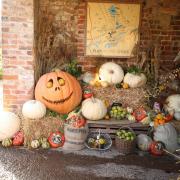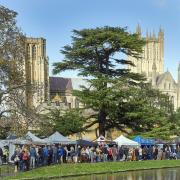Explore with us the secrets of Somerset’s submerged and derelict villages

A fenced off road leads into the scenic reservoir of Chew Valley Lake on the edge of the Mendips. When water levels sink far enough in dry periods, the reason for this inaccessible road to nowhere is revealed.

The village of Moreton had to be evacuated in the early 1950s. The area was to be submerged to form a reservoir needed to cope with the demand for drinking water in Bristol and surrounding areas.
It was later opened by the Queen in 1956. Evidence of a settlement dates back to medieval times, with Moreton listed in the Domesday Book.
Farming was the main activity in the village, and several farms could be found in the area.
George Curry was the last person to run Moreton Farm, he was also known for making homemade cider and having the only car in the village.
Milling was another local industry. Stratford Mill survived the flood, having been demolished and then rebuilt at Blaise Castle in Bristol.
Now a grade II listed building, it is available for visitors to see. Centuries old Herriot’s Mill, the first of the mills to be flooded, is remembered in Herriot’s Bridge which crosses the lake, and the Herriot’s Pool part of the lake.
Just as civilisations rise and fall, individual settlements have thrived and later been lost for various reasons.
Across Britain many communities have gone over the millennia. While some have left little or no trace on the modern landscape, more recently there are lost villages in Somerset whose remains are still visible.
Into the 19th century, Clicket was a small community hidden away in an Exmoor valley south of Timberscombe, one of many isolated hamlets and villages dotted across Britain.
The 1851 census records about 40 people living in the village. William Langdon was the miller listed in the census, Clicket Mill being one of the principal buildings.
Pack animals were used to transport corn to and from the mill along the many trails in the area because the terrain was unsuitable for carts.
Indeed, William Langdon owned two donkeys (called Dick and Short) which were used to collect corn from certain farmers for milling.
Clicket had none of the amenities found in other villages – no church, shop or school.
Residents would have travelled to nearby Timberscombe or Luxborough for church services, but a large house in Clicket was known to have been used for meetings, religious or otherwise.
A Bible Christians magazine mentions a congregation of 70 at one gathering, and this would have included people from outside Clicket.
School children had a difficult walk of two miles through the valley to Timberscombe, sometimes in poor weather like heavy rain or thick fog. In snow, travel must have been even more arduous, and possibly dangerous.
Attendance of some of the children at school was sporadic, especially at harvest time when they would have been expected to help out.
As the 19th century drew to a close, economic changes affected many rural communities. Clicket was no exception, and was impacted more than some other villages.
Competition from more efficient mills making use of mechanisation, coupled with Clicket’s poor access without carts, left the mill closed down and abandoned by 1900. By then, people had already been leaving the village to seek a better life elsewhere.
The last people to live in Clicket, albeit unofficially after it had been deserted, were an elderly couple.
Desperate to avoid going to a poorhouse after being evicted from their cottage, they moved into the derelict mill despite it having no windows or doors.
It is thought that the woman had no choice but to go to the poorhouse when her husband died about a year later.
Another lost village is Stoke Bottom, in the Mendip Hills, which was once recorded as having about 40 houses.
Situated in a coal mining area, its main industry was papermaking. While the nearby Wookey Hole paper mill is still operational, albeit as a visitor attraction, the mill and cottages at Stoke Bottom are now only ruins, like Clicket.
Many smaller paper mills in the area closed because of Wookey Hole’s success. This is perhaps why Stoke Bottom declined to the point of abandonment.
The Georgian mansion known as Stoke House may have been empty in 1905, and is long gone.
By 1928 it was still standing, but later dismantled piecemeal for its stone to be used in other buildings. Parts of the cellars still remain.
In two adjoining counties, other lost villages have a different story to tell.
A few ghostly, scattered remnants of Imber village lie hidden in a fold on Salisbury Plain.
Now part of the defence estate, many of the original village buildings are gone – a few remain in a gutted state to be used in urban warfare training.
The church was left untouched. It is open to visitors on certain days when public access to Imber is allowed.
Clicket and Stoke Bottom may not be as well known, or as enduring, as neolithic sites such as Glastonbury, but they are part of the county’s social history and deserve to be remembered





























